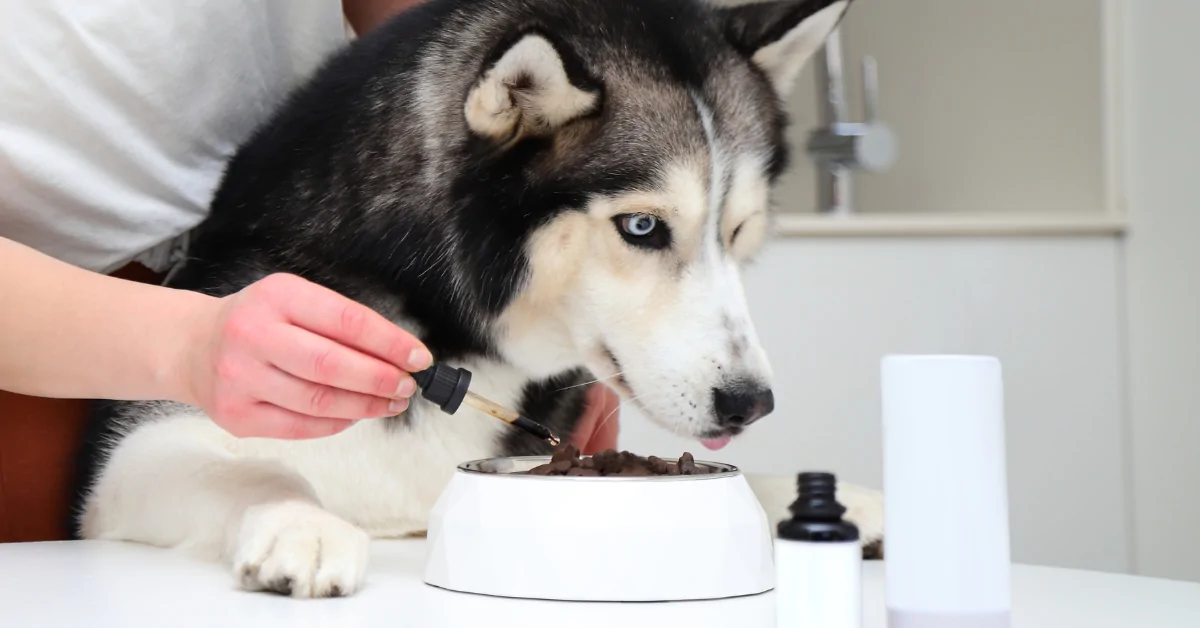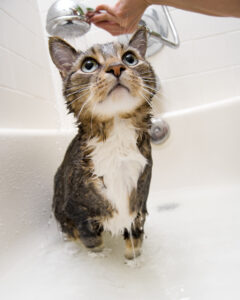If there’s one thing we’re thankful for, it’s that cats seem to have the art of grooming down to a science: lick, then lick again.
It’s so simple and intuitive it might as well have been designed by Apple.
Unfortunately, it’s not as if this is a fool-proof way to approach grooming. Your cat may still need additional bathing, but a key question to answer is “How often should I bathe my cat?”.
Well, in the following short article, you’ll get the answer to that question, as well as a handy guide for how to actually bathe your pointy-eared pal. So, let’s get into it!
How often to Bathe your Cat
It seems like an unnecessary question, right?
“Isn’t that why cats lick themselves?” You ask. “Don’t they give themselves baths all the time?”
Well, yes, they do. But, licking alone isn’t a sufficient-enough method of bathing to actually maintain the health of every cat’s coat and skin. For this reason, The National Cat Groomers Institute of America recommends that you bathe your cat every 4 – 6 weeks. However, the optimal frequency with which you should bathe your furry friend depends on a number of different factors.
In other words, the question of how often you should bathe your cat is the always-unsatisfying answer of:
It depends…

Second, what type of coat do they have, and how long is it? If your cat is a Maine Coon or a Persian, for example, and has lusciously soft, long hair, then they’re likely to need more frequent baths. However, if your cat is an American Shorthair, they’re more likely to be okay with less frequent baths.
Their activity level will also determine how often you need to bathe them, too. If your cat is very active, that means that they’re sweating more and also likely to pick up more debris from the ground as it kicks up around them while they run and play. That means that more active cats require more frequent bathing than cats whose primary form of activity is walking from their bed to their food bowl.
Finally, you need to consider whether or not your cat is dealing with any pervasive health issues such as ticks, fleas, or other skin problems. Additionally, if your cat suffers from certain skin allergies, they may need more baths to help manage their symptoms.
Banixx for Cats
Of course, the best antidote to ailments like skin infections on cats is to use Banixx for Cats! This clinically-tested formula provides instant, sting-free, odorless relief from a variety of bacterial and fungal maladies without relying on pesky antibiotics or steroids. Simply identify the affected area, apply gently each day for a few days, and watch your cat regain their comfort. With Banixx, relief really can be that simple.
So, okay: you’ve identified how often you should bathe your cat. But, how do you actually do that? How do you bathe your cat? Well, keep reading!
How to Bathe Your Cat
What you need to bathe your cat
Before you begin bathing your cat, you’ll need to gather a couple of things.
Namely, you’ll need a simple grooming shampoo that’s labeled specifically for cats, some towels and washcloths, and something that floats and can keep them distracted, like a ping pong ball!
You know – like how you have to distract babies with rubber duckies. Same deal here. Makes sense, right? They are your fur baby after all.
Also, and this should really be said: do not use human shampoo on your pets. Human shampoo can be way too harsh on the skin of dogs and cats and, in some cases, can even be toxic.
How to Prepare Your Cat to Bathe
Preparing your cat for bathing starts long before they get wet.
First, you have to pick where you’re going to bathe them. A bathtub is fine, but it may be more comfortable to bathe them in a waist-high sink. Make sure that you move everything that can possibly break as far away from the bath site as possible. Also, you’ll want to remove anything from the bath site that may offend, frighten, or anger your cat – this can include things like mirrors, certain objects, or things with a strong odor.
Then assemble all of your bathing supplies by your bathing area. Place a towel or rubber mat at the bottom of your bathing vessel. This will make sure your cat doesn’t slip and slide and freak out. Once all that’s done, begin running your water. It should be pretty warm, but it should not be hot to the touch. You’ll also want to make sure that you’re wearing older casual clothes. You May get wet!!
Now that you’ve set up your bathing area, it’s almost time to begin the actual process of, you know… bathing the cat! But, first, some pampering. Make sure to brush your cat’s fur thoroughly before bathing them. This both gets mats out of the fur and also helps them calm down. Taking some time to intentionally soothe them and cuddle them will also come in handy for creating a safe, comfortable environment for her before you get her wet.
After any mats have been resolved and the fur is nice and smooth, now it’s time to get that cat wet.
How to Bathe Your Cat
There’s two basic methods you have at your disposal for bathing your cat: dip, or spray. However, we also recognize that some cats are what you might call…. Extra fluffy. Chonky, if you will. So, in that case, dipping them into a sink full of water might be akin to dipping a full-sized truck into your tub: it’s not gonna happen. If this is the case, you may want to opt for the ladle method where you place her in the sink and simply use a ladle to lightly wash over their fur with water. For first time around, you may opt for a dry sink (with towel/mat in the bottom) and a side container of warm water that you can gently ladle over her.
Otherwise, you’ll have to use the spray method. Unfortunately, some cats get really wigged out at running water near them. So, if you have a detachable spray nozzle on your faucet, you can run it on its lowest-force setting close to your cat’s fur to minimize the chance of them seeing the spraying water and having a negative reaction to it. But remember: do not ever spray your cat in the face. Instead, use a damp washcloth to lightly wet and wash their face.
Whichever method you choose, the general steps to bathing your cat go like this: rinse beginning at the neck and steadily move down their back, making sure to get beneath their tail and on their stomach. Then, put a little bit of cat shampoo in your hand, and begin gently lathering their coat. Once their fur has been shampooed, reapply water in the same method outlined above.
Patience is the Key
It’s important that you stay patient, calm, and loving during this entire process, and that you make sure not to scold your cat if they try to escape the bath. Some cats just aren’t super comfortable in the bath, and that’s okay! It may be that you take the above bath procedure and break it down in segments. Get your cat acclimated to each stage successfully before moving on to the next stage. This is supposed to be as much a bonding experience with your cat as it is a functional process. Don’t be afraid to abort the program in its early stages, while things are still going well and pick it up again later in a week or so. Make each stage a good experience for both of you. And, of course, if you can begin the bathing routine while your cat is still very young, all the better !!
Once your cat has been rinsed off, they’re clean! Now all that’s left to do is wrap them in a clean towel (or two, or three if they’re a longhaired breed) and let them dry off! If your cat is feeling extra fabulously cool about the process, you just may even be able to run your blow dryer on them – just be sure to use the lowest setting! But, this is a giant leap for any cat, so, again, easy does it, approach it in small stages.
Keep Reading Banixx Blogs
After she’s fully dried off, let her run around and show off her shiny, new coat. Just remember that you’ll need to keep bathing her every so often if you want her to keep looking, feeling, and smelling this good. But we know you will! You obviously want to keep your cat happy and healthy – otherwise you wouldn’t be reading our blog!
Speaking of….. Do you know when the best time for your cat to have a nice, shiny new coat is? When they’re going on vacation and you can show them off, of course!
For sure, we know by now that you care a lot about your cat’s health – otherwise you wouldn’t be reading this blog! That’s why we hope you’ll come back to our blog to learn more about how to keep your purr-fect, furball friend happy and healthy. If, on the other hand, you are interested in how to treat cat hot spots, or how to treat your cat’s ear infection, we cover that too. Or are you interested in more quirky items? such as why does my cat get hairballs, we’ve got that covered.
Sources
https://groomwise.typepad.com/ncgia_national_cat_groome/2011/11/
https://www.petfirst.com/pet-care/how-often-should-i-give-my-cat-a-bath/
https://blog.healthypawspetinsurance.com/cat-baths-101-the-when-and-how-to-bathe-a-cat
Share this Post
Featured Post
Recent Posts

Managing the Mamas –Part 2 –The development process

Managing the Mamas: Part 1 – Preparing to Breed Your Mare

HOW MANY TOES?? Caring for the Polydactyl Cat

Do Dog Joint Supplements Actually Work?

Are Laser Pointers Bad for Cats? or, are they Purr-e Fun?





